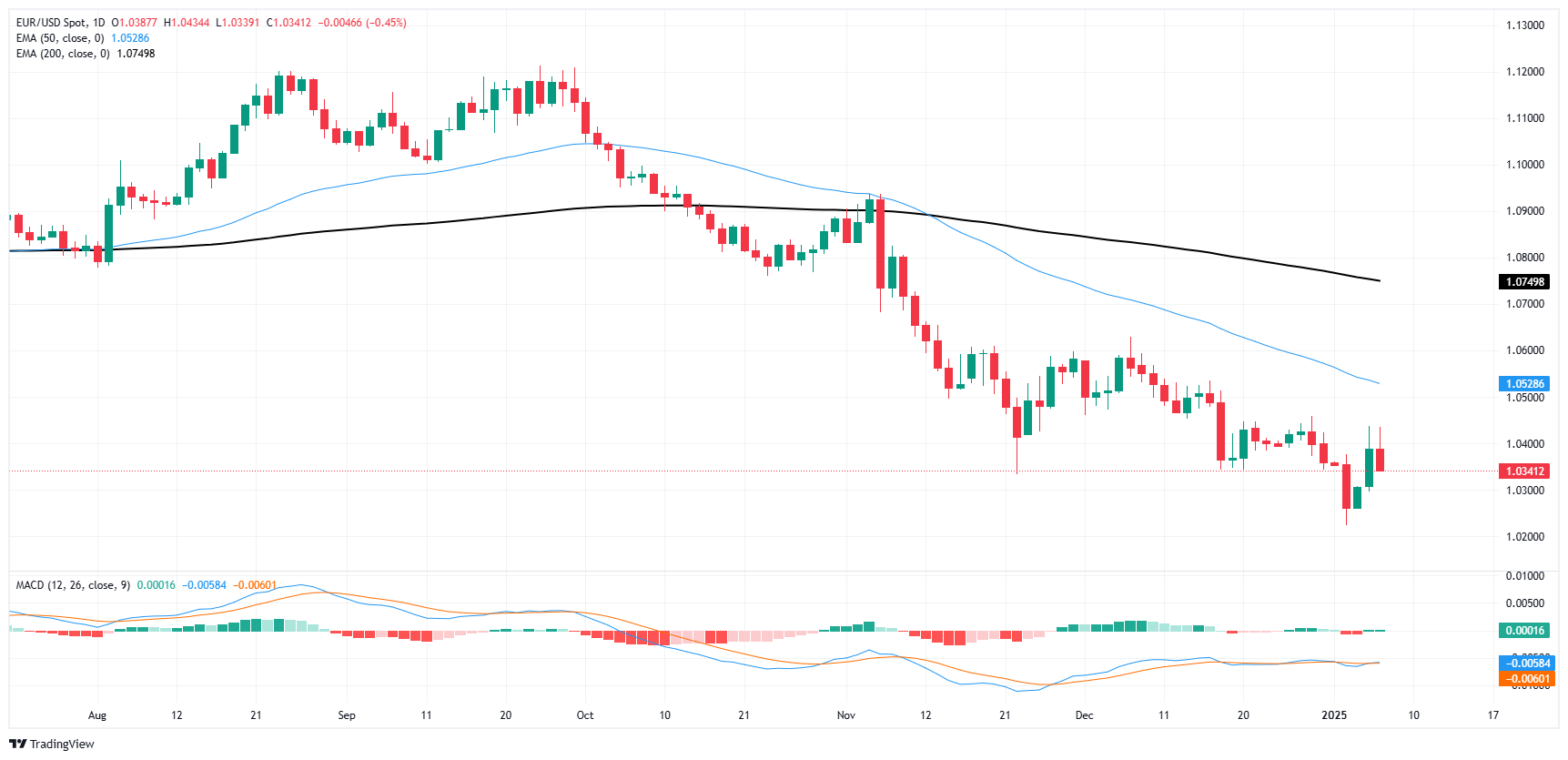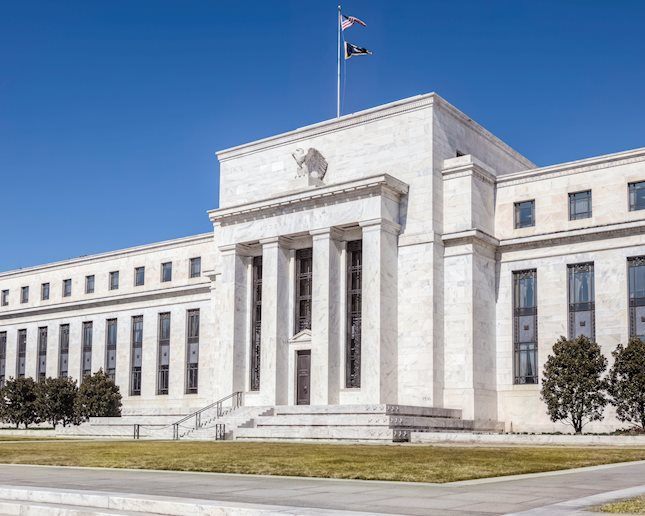- EUR/USD failed to extend a near term technical recovery, sheds 0.4% on Tuesday.
- German Retail Sales, EU PPI inflation, US ADP jobs preview on the docket for Wednesday.
- Another NFP Friday looms ahead, crimping market momentum as Fed rate cut fears weigh.
EUR/USD turned tail and swooned against the Greenback on Tuesday, shedding four-tenths of one percent after a failed recovery of the 1.0400 handle fizzled out completely. The pair is still trading up from last week’s 26-month low, but not by much. Euro bulls are in desperate need of a turnaround as Fiber continues to grind its way back toward 1.0200.
European Harmonized Index of Consumer Prices (HICP) inflation came in about as expected, with annualized HICP for the year ended in December ticking upwards slightly to 2.4% YoY from the previous 2.2%. However, most of the upward pressure in European inflation figures appears to be either baked into older numbers, or is non-structural ticket items, giving Euro traders some hope that things will continue to improve.
On the US side, ISM Services Purchasing Managers Index (PMI) business activity survey results came in much hotter than expected, as did ISM Services Prices Paid. Both figures were for the month of December, igniting fresh market concerns that the Federal Reserve (Fed) may not be able to deliver near as many rate cuts in 2025 as investors had initially hoped.
Early Wednesday, German Retail Sales and pan-EU Producer Price Index (PPI) inflation data are set to be released, with market forecasts indicating a robust rebound in both metrics. Meanwhile, in the US, December ADP Employment Change figures and the latest Meeting Minutes from the Fed are scheduled for release during the upcoming trading session. The ADP employment figures are seen as an unreliable predictor of what Friday’s Nonfarm Payrolls (NFP) data may reveal, but traders won’t let that stop them from overreacting to large deviations from forecasts. Investors will be looking for any signs that could point to a potential rate cut before June, which would include a pronounced, but not too severe, softening in the labor market.
EUR/USD price forecast
EUR/USD continues to churn on the low side as the US Dollar remains the market’s favored jumping-in point. The pair has shed a little over 6.5% since peaking just above 1.0900 in early November, chalking in a clean technical rejection from the 200-day Exponential Moving Average (EMA) which is now grinding its way down into the 1.0700 handle. Fiber bulls hoping to cement in a fresh bull run from multi-year lows will need to first contend with the 50-day EMA, which is descending into 1.0500.
EUR/USD daily chart
Euro FAQs
The Euro is the currency for the 19 European Union countries that belong to the Eurozone. It is the second most heavily traded currency in the world behind the US Dollar. In 2022, it accounted for 31% of all foreign exchange transactions, with an average daily turnover of over $2.2 trillion a day. EUR/USD is the most heavily traded currency pair in the world, accounting for an estimated 30% off all transactions, followed by EUR/JPY (4%), EUR/GBP (3%) and EUR/AUD (2%).
The European Central Bank (ECB) in Frankfurt, Germany, is the reserve bank for the Eurozone. The ECB sets interest rates and manages monetary policy. The ECB’s primary mandate is to maintain price stability, which means either controlling inflation or stimulating growth. Its primary tool is the raising or lowering of interest rates. Relatively high interest rates – or the expectation of higher rates – will usually benefit the Euro and vice versa. The ECB Governing Council makes monetary policy decisions at meetings held eight times a year. Decisions are made by heads of the Eurozone national banks and six permanent members, including the President of the ECB, Christine Lagarde.
Eurozone inflation data, measured by the Harmonized Index of Consumer Prices (HICP), is an important econometric for the Euro. If inflation rises more than expected, especially if above the ECB’s 2% target, it obliges the ECB to raise interest rates to bring it back under control. Relatively high interest rates compared to its counterparts will usually benefit the Euro, as it makes the region more attractive as a place for global investors to park their money.
Data releases gauge the health of the economy and can impact on the Euro. Indicators such as GDP, Manufacturing and Services PMIs, employment, and consumer sentiment surveys can all influence the direction of the single currency. A strong economy is good for the Euro. Not only does it attract more foreign investment but it may encourage the ECB to put up interest rates, which will directly strengthen the Euro. Otherwise, if economic data is weak, the Euro is likely to fall. Economic data for the four largest economies in the euro area (Germany, France, Italy and Spain) are especially significant, as they account for 75% of the Eurozone’s economy.
Another significant data release for the Euro is the Trade Balance. This indicator measures the difference between what a country earns from its exports and what it spends on imports over a given period. If a country produces highly sought after exports then its currency will gain in value purely from the extra demand created from foreign buyers seeking to purchase these goods. Therefore, a positive net Trade Balance strengthens a currency and vice versa for a negative balance.
Information on these pages contains forward-looking statements that involve risks and uncertainties. Markets and instruments profiled on this page are for informational purposes only and should not in any way come across as a recommendation to buy or sell in these assets. You should do your own thorough research before making any investment decisions. FXStreet does not in any way guarantee that this information is free from mistakes, errors, or material misstatements. It also does not guarantee that this information is of a timely nature. Investing in Open Markets involves a great deal of risk, including the loss of all or a portion of your investment, as well as emotional distress. All risks, losses and costs associated with investing, including total loss of principal, are your responsibility. The views and opinions expressed in this article are those of the authors and do not necessarily reflect the official policy or position of FXStreet nor its advertisers. The author will not be held responsible for information that is found at the end of links posted on this page.
If not otherwise explicitly mentioned in the body of the article, at the time of writing, the author has no position in any stock mentioned in this article and no business relationship with any company mentioned. The author has not received compensation for writing this article, other than from FXStreet.
FXStreet and the author do not provide personalized recommendations. The author makes no representations as to the accuracy, completeness, or suitability of this information. FXStreet and the author will not be liable for any errors, omissions or any losses, injuries or damages arising from this information and its display or use. Errors and omissions excepted.
The author and FXStreet are not registered investment advisors and nothing in this article is intended to be investment advice.
Recommended content
Editors’ Picks

EUR/USD stays around 1.0300 ahead of FOMC Minutes
EUR/USD stays under heavy selling pressure and trades around 1.0300 on Wednesday. News of US President-elect Donald Trump planning to declare an economic emergency to allow for a new tariff plan weighs on risk mood. US ADP misses expectations with 122K vs 140 anticipated.

GBP/USD drops to fresh multi-month lows, hovers around 1.2350
GBP/USD remains on the back foot and trades at its weakest level since April, around 1.2350. The risk-averse market atmosphere on growing concerns over an aggressive tariff policy by President-elect Donald Trump drags the pair lower as focus shifts to US FOMC Minutes.

Gold pressures fresh multi-week highs
Gold price (XAU/USD) advances modestly in a risk-averse environment. The benchmark 10-year US Treasury bond yield holds at its highest level since late April near 4.7%, making it difficult for XAU/USD ahead of FOMC Minutes.

Fed Minutes Preview: Key Insights on December rate cut and future policy plans
The Minutes of the Fed’s December 17-18 policy meeting will be published on Wednesday. Details surrounding the discussions on the decision to trim interest rates by 25 basis points will be scrutinized by investors.

Bitcoin edges below $96,000, wiping over leveraged traders
Bitcoin's price continues to edge lower, trading below the $96,000 level on Wednesday after declining more than 5% the previous day. The recent price decline has triggered a wave of liquidations across the crypto market, resulting in $694.11 million in total liquidations in the last 24 hours.

Best Forex Brokers with Low Spreads
VERIFIED Low spreads are crucial for reducing trading costs. Explore top Forex brokers offering competitive spreads and high leverage. Compare options for EUR/USD, GBP/USD, USD/JPY, and Gold.